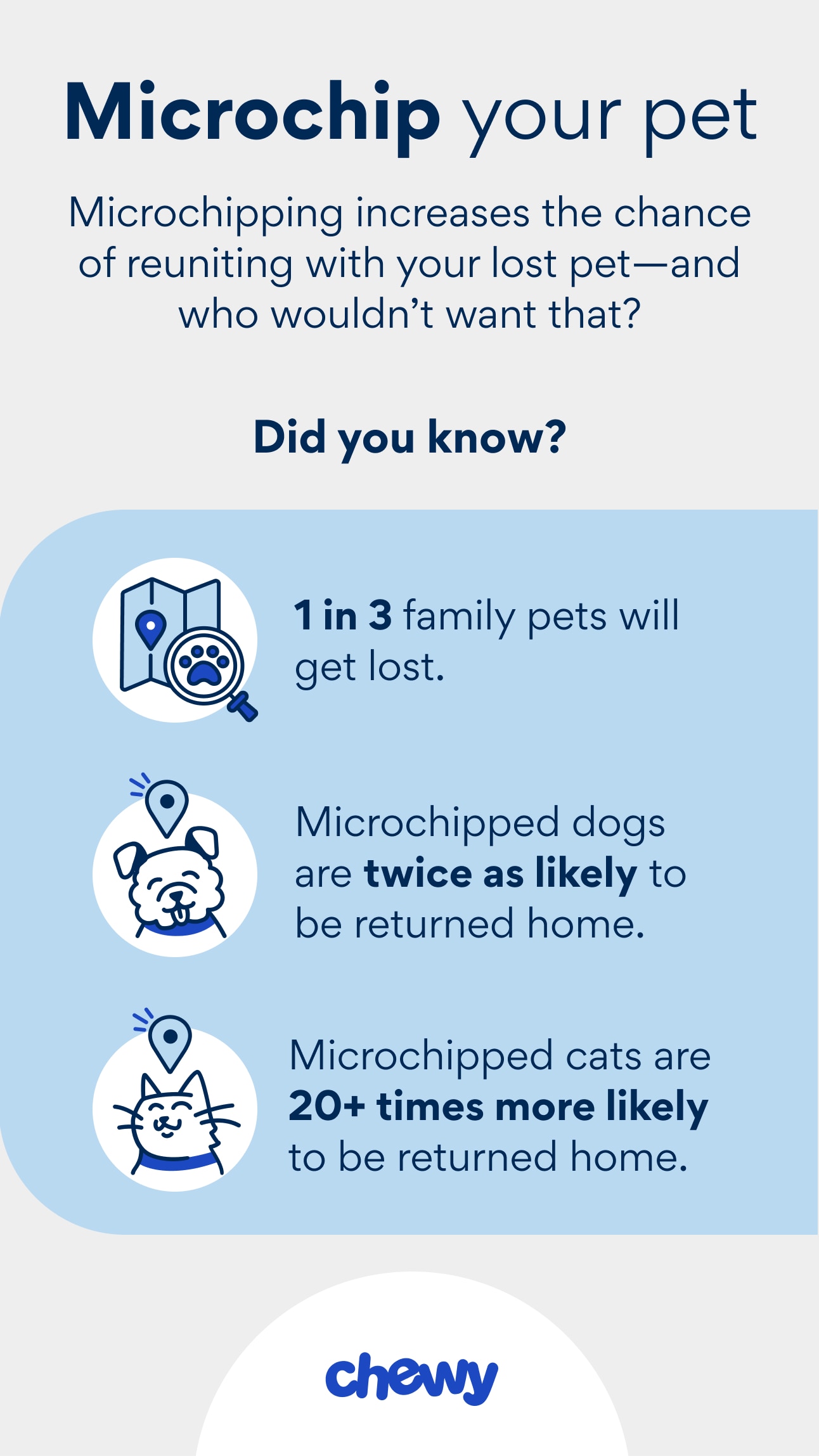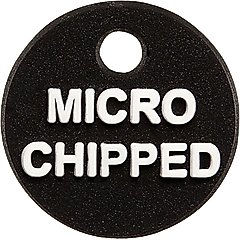What Is a Pet Microchip?

Photo by olgagorovenko/iStock
Pet microchips may sound newfangled and futuristic, but these teeny devices have been around for a long time. They provide us with a reliable way to reunite us with our sweet fur friends in the event they go missing—like by escaping through the front door (how are they so good at that?!) or running off during a storm or fireworks display.
Ahead, we’re answering all your big questions on cat and dog microchips to help you learn more about the power of these little pet IDs, and how to use them to your advantage.
What Is a Pet Microchip?
A pet microchip is a tiny device—about the size grain of rice—that’s implanted just under a pet’s skin. It’s usually placed between the shoulder blades and is considered a permanent form of identification.
“Every pet—dogs, cats, and even exotic animals, small mammals, farm animals, and horses—should be microchipped,” says Colleen Guilfoyle, DVM, veterinarian at Best Friends Animal Society in Kanab, Utah. “The chip itself doesn’t contain your personal information, but it carries a unique ID number.”
When a vet or shelter scans the chip, they get your pet’s unique ID number, which is then looked up in a large database. From here, they can find the contact information you’ve provided, including your address and phone number.
How Do Pet Microchips Work?
A pet microchip isn’t the same as a GPS tracker, like the Petcube Dog GPS Tracker and Activity Monitor, in the sense that it actively tracks your pet’s location. It must first be scanned—typically at a veterinarian’s office, emergency shelter, or humane society—and then the pet parent is contacted from there.
Recommended Product
“GPS collars are great for real-time location tracking, but they can fall off or run out of battery, [whereas] a microchip stays with your pet for life,” Dr. Guilfoyle says.
“Ideally, it’s smart to have both [a GPS tracker and microchip], if possible,” Dr. Guilfoyle adds. “The GPS helps you find a lost pet immediately, and the microchip serves as backup for permanent identification.”
| Feature | Microchip | GPS Tracker |
|---|---|---|
| Real-time location | No | Yes |
| Vet or shelter scanning | Yes | No |
| Works internationally | Yes | Yes |
| Battery/charging required | No | Yes |
| Can be removed or lost | No | Yes |
| Lifespan | Lifetime | Varies (device-dependent) |
| Implantable | Yes (always) | No (usually worn on collar) |
Pro Tips: A GPS tracker can be added to your pet’s collar to provide real-time tracking. Keeping a customized cat or dog ID tag with your phone number on your pet’s collar is also helpful in case they get lost.
Recommended Products
5 Reasons To Microchip Your Pet
Having your pet microchipped is considered standard protocol and one of the most important safety guards you can put in place for your dear fur friend. It also has some other perks you might not have considered.

Photo by Chewy
1. Helps You Find Your Lost Pet
If your pet runs away or becomes lost, they’ll most often find themselves at a veterinary clinic or shelter where they’re immediately scanned.
“When a pet is brought into a place with a scanner, such as a veterinary clinic, animal shelter, or rescue, the scanner can detect a unique ID number and retrieve the owner’s information for contact from the microchip registry website,” explains Dwight Alleyne, DVM, a senior associate veterinarian at Petfolk in Sandy Springs, Georgia.
A 2009 study found that microchipped dogs were returned to their owners 52% of the time (compared to 22% for dogs without microchips), and that cats with microchips were returned 38% of the time versus a very low 2% for cats without microchips.
2. They’re Reliable and Provide Peace of Mind
While GPS trackers are quite handy, the reality is that they can become lost, broken, or lose their charge. Knowing that the implanted chip is always going to work and will always be with your pet provides great peace of mind.
“Microchips work as a passive transmitter, only transmitting information when a microchip scanner is placed over it,” Dr. Alleyne says.
Pro Tip: Want to alert others that your pet has been microchipped? Add a microchip alert ID tag, like the Trill Paws Microchipped Mini Charm, to their collar.
Recommended Product
3. You Can Use Them With Other Pet Tech
Microchips can integrate with other smart pet technologies to make daily life more convenient and secure. For example, microchip-activated pet feeders, like the SureFeed Microchip Feeder, ensure that only the right pet gets access to specific food, which comes in handy for multi-pet households where each pet has different diets.
Recommended Product
Also, microchip-enabled dog and cat doors, like the SureFlap, can give your pet exclusive access to the outdoors, while keeping out strays or wildlife (or ensuring your pup can come and go to use the restroom while your feline stays inside).
Recommended Product
4. They’re Sometimes Required for Travel
If you’re planning to travel internationally with your pet, a microchip is sometimes mandatory (especially when entering countries in the EU, UK, and others with strict import requirements). In many cases, the microchip must meet certain standards and be implanted before rabies vaccination to be valid for entry.
Additionally, some U.S. cities and counties require microchipping as part of local licensing regulations or adoption policies.
In both scenarios, microchipping ensures traceability and helps protect public health by linking pets to their vaccination records.
5. Provides Proof of Ownership in Disputes
Heaven forbid you find yourself in a battle with another person over who your pet belongs to. However, this can (and does) happen in cases where a pet goes missing and another family brings them into their home and claims them as their own.
Having the pet microchip with your up-to-date contact information on it demonstrates proof of ownership.
How To Get Your Pet Microchipped
Most veterinarians can microchip dogs, cats, and other pets during a regular checkup, and many shelters offer the service at low cost or during adoption.
The chip is quickly and harmlessly implanted under the skin between your pet’s shoulder blades.
Once the chip is placed, the most important step is registration: Visit the database associated with your chip’s manufacturer and enter your contact information. Make sure to keep it updated if you change addresses or phone numbers.
Always save your chip number and registration details in a safe place.
Did you know? Many pets adopted from a humane society are already equipped with a microchip as part of the adoption process. (You should still double-check, though.) Those purchased from breeders or elsewhere may not.
How Much Does It Cost To Microchip a Dog or Cat?
The cost of microchipping a pet depends on location, with an average of about $50, says Dr. Alleyne.
Veterinary clinics and animal shelters often offer microchipping during regular visits or special events, and some adoption centers include it as part of the adoption fee.
You may also be able to find free or low-cost microchipping clinics through municipal programs or nonprofit organizations.
How Can I Find Out if My Pet Is Microchipped?
The best way to determine if your pet is microchipped is to go to a facility with a scanner, which is a handheld device that detects and reads most microchips.
A staff member will scan the area between your pet’s shoulder blades to determine if a chip is present and functioning.
If one is found, the scanner will display the unique ID number, which can then be entered into a pet microchip lookup database to find the registry it’s associated with.

Photo by Chewy Studios
FAQs About Pet Microchipping
Q: Can you track your pet with a microchip?
A: You cannot actively track your pet’s real-time location via a microchip. These are passive forms of identification that must be scanned using a special scanning device. Equipping your pet with both a GPS tracker and microchip is advised.
Q: Should I be concerned about my privacy if my pet is microchipped?
A: No, your personal information isn’t stored on the microchip itself. The chip is tied to a unique ID number, and it can only be accessed by authorized facilities and organizations with a microchip scanning tool.
Q: Do I need to keep my pet’s microchip up to date? How?
A: Yes, this is imperative. Microchip information can easily be updated on the manufacturer’s microchip registry’s website. Many registries also let you add secondary contacts, which provides an extra layer of protection in case you’re unreachable during an emergency.
Q: Does my pet need an ID tag if they’re microchipped?
A: Yes, your pet should still wear an ID tag even if they have a microchip. A visible tag with your contact info allows anyone who finds your pet to reach you immediately without needing a microchip scanner, providing a fast and easy first line of defense.
Attributions
This content was medically reviewed by Teresa Manucy, DVM, Chewy veterinarian.








